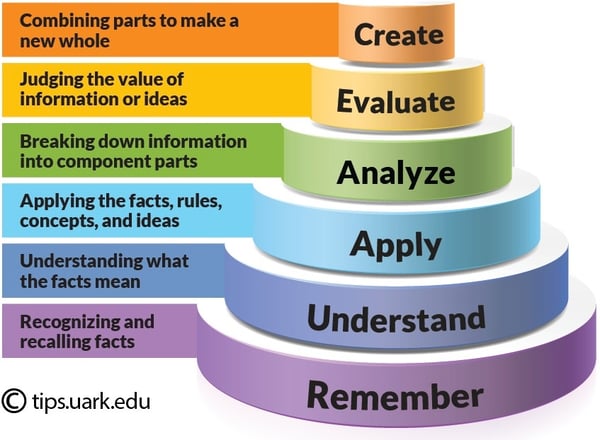How to Use Educational Principles to Develop Staff
Share this
.png?width=800&name=Advisor%20Blog%20Image%20(11).png)
7 MIN READ
If you’re looking to grow your practice, you’re eventually going to find yourself hiring and training additional staff. If you’ve never managed or trained employees before, it can be hard to know how to effectively design a training program that challenges new hires without overwhelming them. This blog explores several educational principles you can integrate into your new hire training program to ensure information is delivered effectively and that your new employees internalize what you’re presenting.
Know Your Audience/Perform a Needs Analysis
While I recommend developing a core training program you can use as a guide for all new hires, you’ll want to consider the needs of each new employee—their skill level and experience, their learning style preferences, etc.—and adapt your training as needed. In order to spend your time effectively with a new hire, you’ll want to immediately assess what the new employee already knows and what they need to be trained on. If you’ve conducted your interview well, you’ll know on your employee’s first day what skills and information need to be presented (and which items you can skip).
| Hiring Tip: When considering which candidate to hire, remember that some skills are much more “trainable” than others. Hiring a loyal, dependable self-starter who may need some training on how your practice operates is almost always a better choice than an experienced candidate who lacks soft skills. Technical skills are easy to teach when the learner is open to new ideas, has a positive attitude, and can think critically. Also remember that as technology changes rapidly, very specialized technical skills can become obsolete quickly. It’s not super critical, for example, that the advisor you’re hiring already knows your software. The chances of you adopting new technology at some point are high, so focus on bringing on board fast learners who won’t be phased by the many changes of a growing company. |
Consider Different Learning Styles
As part of your individual needs analysis for each new employee, it can be helpful to understand not only what the employee already knows, but also how they learn best. You can ask new employees about their preferences or have them take a quick learning style quiz. This can tell you how heavily to lean on certain types of training tools. According to the VARK Model, most individuals prefer one of four main ways of learning:
- Visual
- Auditory
- Reading/writing
- Kinesthetic
Once you know which of these learning styles your new hire prefers, you can tailor your training as needed:
|
Learning Style Training Tips |
|
|
Visual |
Use visual tools and training such as infographics, screencasts, and whiteboarding |
|
Auditory |
Plan on spending time discussing new concepts; ask the employee to explain things back to you |
|
Reading/Writing |
Present reading material that the employee can review before one-on-one training sessions; be sure to develop a training manual for these employees that can be referred to repeatedly |
|
Kinesthetic |
Create hands-on training activities, the more interactive the better; avoid hypothetical and theoretical scenarios |
Ultimately, we recommend that your training program address various types of learning styles. Consider adding a lot of screenshots to your walk-throughs and even recording video training sessions for your new hires. Screencastify and Screencast-O-Matic are both free tools (with paid add-ons) you can use to record on-screen walk-throughs and tutorials.
Managing Different Personalities
The learning style concept can be extended to the idea that employees with different skill levels and personalities should be managed differently. This idea, called situational leadership, is based on the principle that there is no one “best” style of leadership, and that you should be able to adapt your leadership and management style to the needs of specific employees and to the changing dynamic of your organization.
If you’ve managed before, you’ve probably noticed that some employees need a lot of direction and feedback, while others thrive when allowed more creativity and freedom in their work. Even in neutral or positive situations, such as performance recognition, consider the employee’s personality and work style. Some people love a public mention of a project that went well and want to share big wins, while other prefer this kind of feedback in private.
Whatever the situation, avoid taking a one-size-fits-all approach to managing your employees. You’ll demonstrate that you see each of your employees as individuals while helping your staff do their best work.
Daniel Goleman, best known for his research and writing on emotional intelligence, describes six main leadership types in his book Primal Leadership:
- Visionary: “Visionary leaders articulate where a group is going, but not how it will get there—setting people free to innovate, experiment, and take calculated risks.”
- Coaching: “Coaches help people identify their unique strengths and weaknesses, tying those to their personal and career aspirations.”
- Affiliative: “The affiliative style represents the collaborative competence in action. Such leaders are more concerned with promoting harmony and friendly interactions, nurturing personal relationships that expand the connective tissue with the people they lead.”
- Democratic: “The democratic style builds on a triad of emotional intelligence abilities: teamwork and collaboration, conflict management, and influence.”
- Pacesetting: By focusing on performance standards and goal setting, the pacesetting strategy can be appropriate “in getting high quality results from a motivated and competent team.”
- Commanding: The commanding style focuses on “influence, achievement and initiative,” with the leader exerting “forceful direction in the service of getting better results.”
Based on his research of the styles and effectiveness of nearly 4,000 executives, Goleman argues that the ability to move seamlessly between leadership styles is critical to building a positive and successful organization. Consider which of the leadership styles listed you feel most comfortable with, and which might be effective for specific types of situations and employees.
Bloom’s Taxonomy
As you’re assessing your employees’ individual needs in training and management, it can be helpful to consider where each employee is cognitively with regard to specific skill sets. Bloom’s Taxonomy is a model that illustrates a hierarchy of learning, and can be viewed as a path toward more sophisticated ways of understanding and processing information. The most basic skills (described as cognitive domains) are shown at the bottom of the pyramid; these are are the fundamental ways of understanding information.
Bloom’s Taxonomy of Learning Domains

The goal is to move up on the hierarchy toward more complex domains: analyzing and evaluating new information or creating something original, for instance. You can use this concept as you’re training a new employee to complete more sophisticated tasks and gain more advanced skills.
For example, maybe you have a paraplanner on staff who’d like to become a financial advisor. As you train this person, you’ll be moving up the hierarchy into more complex ways of working with clients and financial plans.
In working with clients, the paraplanner is likely here:
|
Domain |
Task |
|
Remembering |
Describe firm policies and procedures |
|
Comprehending |
Understand your financial planning software |
|
Applying |
Modify and update financial plans based on client needs |
And you’re guiding them to this level:
|
Domain |
Task |
|
Analyzing |
Analyze the effectiveness of a financial plan |
|
Evaluating |
Assess a new client’s risk tolerance |
|
Creating |
Create and maintain new client relationships |
Another important component of Bloom’s model is framing outcomes you’d like to see from your employees in terms of specific objectives. If you’re looking to help your staff advance, be specific about what it is you’d like them to be able to do, when you’d like them to do it, and how they’ll be demonstrating the skill. Build this into a 90-day plan for new hires or as part of annual or quarterly goal setting documentation.
Also, when you have employees complete training, be sure to specify what you expect them to do with the information. For example: “After you complete this training, you should be able to set up each new client on the AdvicePay platform within one week of onboarding.” This will create specific expectations for the employee so they’re aware of how you’re measuring their success.
Assessing Learning: Individual Employees
Once you’ve trained a new employee on a specific skill—and articulated how and when they’ll use the information they’ve learned—it’s time to assess whether they’ve actually internalized what’s been presented. This should enable the employee to demonstrate an understanding of what’s been presented in the training. This way, you’ll be certain you can delegate specific tasks and know they’ll be completed successfully.
For example, if you’re asking your paraplanner to complete paperwork for you, have them complete a practice form so you can assess and give feedback. If you’re asking them to run a new report for this first time, review the report and ensure that it’s what you’ve asked for. Then evaluate immediately to close the feedback loop.
Get new employees performing tasks sooner rather than later so you can provide immediate feedback. They will ask better questions and will be immediately aware of areas where they might need further training.
Assessing Your Training Program as Whole
When developing training, many instructional designers use a model called ADDIE. This model uses the following steps in developing training:
- Analysis
- Design
- Development
- Implementation
- Evaluation
I’ve touched on several important factors that relate to steps in this process—how to analyze an employee’s skills and learning style, taking into account work style and personality, and tips for designing an effective training program using this information.
An often overlooked step in the development process is evaluating your program’s effectiveness as a whole after you’ve implemented it. We recommend that you quantify the benefit to your organization, no matter what the training. After you’ve trained a new employee, or after you conduct a firm-wide training, plan on creating a system for measuring the outcomes you are seeking. This assessment can take a number of forms, including an employee survey, employee interviews, performance monitoring, and measuring KPIs (like additional leads/prospects, increases in AUM, and client satisfaction).
As you grow your firm, be sure to take some time periodically to revisit your new hire training, and any ongoing training you use for your staff. Ask staff who’ve gone through the training for feedback and find out what aspects have worked well for them, and which they could live without. It takes time and resources to develop an effective training and onboarding program, but the investment is well worth the return.
 About the Author
About the Author
Kate Ross has spent the last ten years of her career developing educational materials for financial professionals and brings a passion for instructional design and curriculum development to the XYPN team.
In her free time, Kate can be found front row at a concert, camping in the woods, floating a river, or hiking in the mountains near her home in Montana.
Share this
- Advisor Blog (690)
- Financial Advisors (219)
- Growing an RIA (99)
- Digital Marketing (86)
- Marketing (83)
- Community (81)
- Start an RIA (75)
- Coaching (72)
- Business Development (70)
- Running an RIA (70)
- Compliance (69)
- Client Acquisition (65)
- Technology (64)
- XYPN LIVE (59)
- Entrepreneurship (56)
- Sales (48)
- Practice Management (44)
- Client Engagement (41)
- XYPN Books (38)
- Bookkeeping (37)
- Investment Management (37)
- Fee-only advisor (34)
- Lifestyle, Family, & Personal Finance (31)
- Employee Engagement (30)
- Client Services (25)
- Financial Education & Resources (24)
- Market Trends (21)
- Journey Makers (20)
- Process (14)
- Niche (11)
- SEO (9)
- Scaling an RIA (8)
- Career Change (7)
- Partnership (6)
- Transitioning Your Business (6)
- Transitioning To Fee-Only (4)
- Social Media (3)
- Transitioning Clients (3)
- Emerald (2)
- Persona (2)
- RIA (2)
- Onboarding (1)
- Sapphire (1)
Subscribe by email
You May Also Like
These Related Stories

Creating a Culture of Accountability in Your Financial Planning Firm
Feb 12, 2018
6 min read

How to Create Online Training: 11 Steps for Financial Advisors
Sep 7, 2020
9 min read



